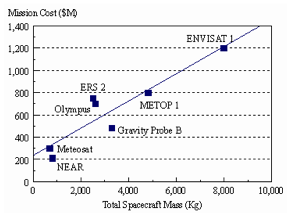Budget
| Communications Components* | ||||
| Component | Raw Price(USD) | Factor | Space Hardened Price (USD) | |
| BPSK Modulator: ComBlock COM-1402 | 295 | 4 | 1180 | |
| BPSK Demodulator: ComBlock COM-1001 | 295 | 4 | 1180 | |
| Ka-band Block upconverter | 1000 | 1000 | ||
| LNA: NEC/Toshiba Space Systems Ka-band LNA | 1000 | 1000 | ||
| Ka-band Downconverter: NEC/Toshiba Space Systems | 1000 | 1000 | ||
| Antenna: HDA antenna (custom design) | 10000 | 10000 | ||
| 15360 | ||||
| Propulsion System ** | ||||
| 1.602E12 | ||||
| Power System *** | ||||
| Component | Individual | Number per Relay/Probe | Number of Relays/Probe | USD |
| RTG | 1000000 | 4 | 10 | 40,000,000 |
| Total Cost | 1.60204E12 | |||
* Prices for communications electronics were based on instances of common commercially available components. When prices were not available, they were estimated. For components that were not space hardened, a factor of four was used to estimate the increased price
** Prices for the propulsion system were extrapolated based on the propulsion system costs for other space probes
Fig.1: Mission Cost versus Total Spacecraft Mass
Mission costs can be broadly estimated from the mass of the spacecraft. The fig.1 provides cost estimation (blue line) of spacecraft Mission with respect to the Total Spacecraft Mass. If we assume the linear extrapolation can still be used for our interstellar mission (M=1,250t), the estimated cost of this mission will be $M 178,000*9=$M 1,602,000 which is about 13% of the American GDP.
This cost value is a big approximation since it is based on the current cost of spacecraft launcher. For our interstellar travel, we will use a new and state of the art non-chemical propulsion system which require several years of Research and development. The Research and development cost is very difficult to estimate in this case.
Propulsion Cost Estimation:
Total liquid hydrogen volume: 18,436 l
Total liquid hydrogen cost: $55,309
*** Power System Cost
The primary component to the power system of each relay and the probe is the RTG, therefore the price for the power system was based on the value of a single RTG. Each relay as well the probe has 4 RTGs.
Website reference:
http://www.yorku.ca/bquine/pages/mission_costs_and_reliability.htm